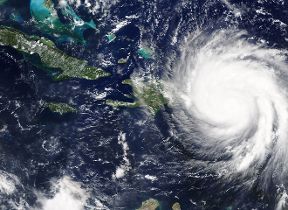Storm surge
A storm surge is possibly one of the most dramatic weather events in the UK, resulting from low pressure, high winds and tidal conditions.
What is a storm surge?
A storm surge is a change in sea level that is caused by a storm. They can lead to extensive flooding and are dangerous for people living in many coastal areas. For example, when Hurricane Katrina approached the US coast in 2005, it generated a storm surge of more than 8 metres in some areas. This led to widespread flooding, including almost all of the city of New Orleans where the sea defences couldn't cope with the water level. More than 1800 people were killed across the US by Hurricane Katrina, many of them by the storm surge flooding.
What causes a storm surge?
The main cause of a storm surge is high winds pushing the seawater towards the coast, causing it to pile up there. There is also a smaller contribution from the low pressure at the centre of the storm "pulling" the water level up, by about 1 cm for every 1 millibar change in pressure. This is called the inverse barometer effect and is similar to what happens when you drink through a straw.
The strong winds in the storm generate large waves on top of the surge which can cause damage to sea defences, or spill over the top adding to the flood risk. In the case of tropical storms (such as hurricanes), there may also be a very large amount of rain which further increases the risk of flooding.
On the 5 December 2013, a large storm surge hit the east coast of the UK, causing widespread flooding along the coast. This was a prime example of low pressure, high winds and high tidal conditions combining.
Negative storm surge
It is also possible for a negative storm surge to occur, when the wind direction blows the water away from the coast instead, causing the sea level there to drop. These are less dangerous than positive storm surges as they do not bring the risk of flooding, but they can damage ships in port and leave them stranded until the water level rises again.
The height of a storm surge depends on many factors such as the size and strength of the storm, the direction it approaches the coast and the shape of the coastline and seabed.
In areas with large tides, such as the UK, the timing of a storm surge is particularly important and just a couple of hours' difference may mean the difference between an area being flooded or staying safe.
1953 east coast flood
In the night of 31 January 1953, a storm in the North Sea caused a storm surge which occurred at the same time as a high spring tide. Although the storm and surge were forecast in advance, public warning systems were not very effective at this time and many people were not prepared for the flooding. More than 2500 people were killed around the North Sea coastline, including 307 in England and 19 in Scotland. As well as the loss of life, the flooding caused a great deal of damage to people's homes and businesses and ruined large areas of farmland.
Following the 1953 storm surge, the UK Government invested much more in improved sea defences, such as the Thames Barrier, and effective warning systems. Keep up to date with all the latest flood warnings, including coastal flood warnings, on our website.





